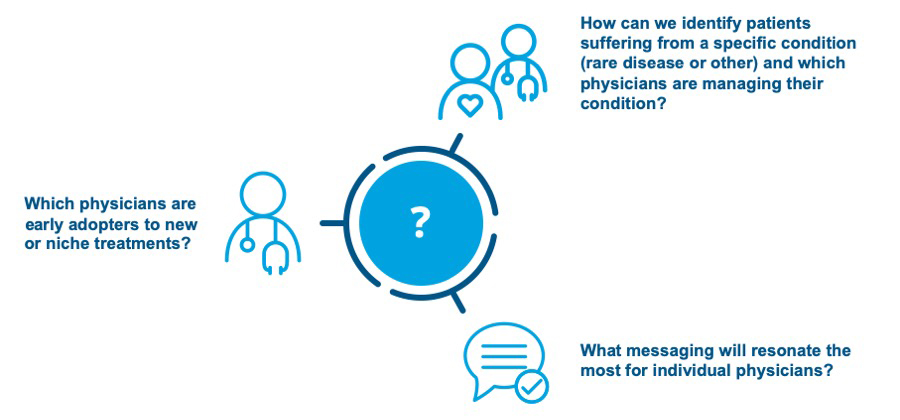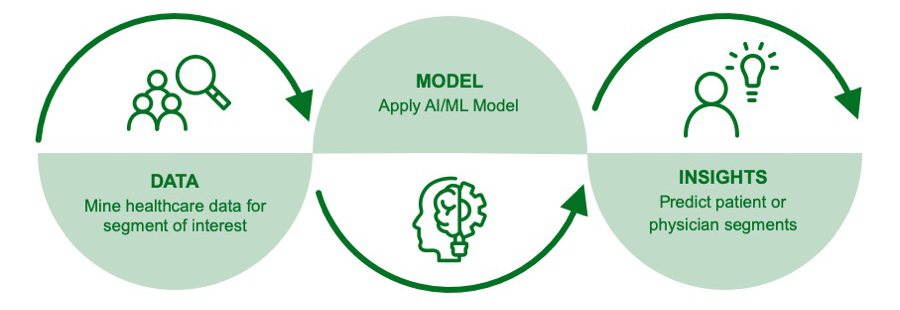











As discussed in the last blog of this series, Artificial Intelligence (AI) and Machine Learning (ML) are now being leveraged to generate Real World Evidence to support stakeholder decision making in healthcare. There are also multiple commercial applications where AI/ML is being implemented to provide unprecedented actionable insights. One such example is the use of AI/ML to predict key patient and physician segments in order to advance treatments and improve outcomes.
Use of AI/ML to Answer Life Sciences’ Key Business Questions

IQVIA is applying AI/ML algorithms and deep subject matter expertise to its wealth of granular healthcare data to address questions such as those listed through predictive segmentation. A simplified view of the approach, as it would be applied to predict either patient or physician segments, can be illustrated as follows:

Predicting Patient Segments
When applying this approach to predict patient segments, de-identified longitudinal data (anonymized at the source) from retail pharmacies, insurers or electronic medical records usually serve as the basis. A “training cohort” of patients exhibiting the specific characteristics of interest is selected to train the AI/ML model. The trained model is then applied to the full dataset to identify patients that are predicted to display the same characteristics as the initial training cohort.
Examples of the application of AI/ML to predictive patient segmentation include:
Identifying undiagnosed, untreated, or at-risk patients
Desired segment is comprised of patients suffering from a rare disease, strong candidates for a novel product, or even patients at risk of developing a condition in the future.
A training cohort is defined based on the use of a specific therapeutic flag and the treatment history for these patients serves as input for the model.
AI/ML allows us to elucidate patterns in the patients’ demographic characteristics and concomitant medications that could not have been detected through more traditional approaches.
Applying the trained model to the full universe allows for segmentation of patients based on the potential benefit they could obtain from the treatment.
Identifying patients using a therapy for a specific indication
While Canadian healthcare data is rich and granular, the lack of diagnosis information can complicate obtaining insights where products are used across multiple indications. In this case, a training cohort can be defined based on the use of a specific therapeutic marker and subsequently used to train the AI/ML model. If no such marker exists, data from an alternative geography where indication is captured (e.g. USA) will occasionally be leveraged to inform the model. The insights obtained from the model allow for efforts to be focused on predicted segments that are truly being treated for the indication of interest.
Predictive patient segmentation, as described above, can provide invaluable insights to better understand how therapies are used in practice. Furthermore, by linking predicted patient segments to the physicians responsible for treatment, companies can ensure allocation of resources and efforts where they are most needed.
Predicting Physician Segments
When applying AI/ML methodologies to predict physician segments, while anonymized longitudinal patient-level data may be leveraged in certain scenarios, prescribing data originating from retail pharmacies is typically the focus. In this application, the training cohort is a group of physicians that either exhibits a desired behavior or shares a common attribute. The prescribing behavior for these physicians is used to train the AI/ML model which then provides a segment predicted to share the specific attribute.
Examples of the application of AI/ML to predictive physician segmentation include:
Predicting Relevance to Physicians’ Practice
- In this case, the desired segment could be physicians that are likely to prescribe a novel product or simply identify untapped opportunity within an established market.
- A physician segment is defined based on the use of the product of interest, or a relevant analogue.
- Prescribing behavior (total script volume, therapeutic initiations, switches, market shares, etc.) across multiple markets as well as physician demographics could be leveraged to train the AI/ML model.
- Applying the trained model to the full universe yields a segment of physicians that are predicted to be strong candidates to prescribe the product of interest.
Predicting Physicians that Share Specific Attributes
- Whether attitudinal or psychographic segments acquired through primary market research, or behavioral segments limited to a subset of physicians, obtaining similar insights across the universe of physicians is often desired to inform commercial strategy and messaging.
- Again, prescribing across markets and demographic data are used to train the AI/ML model.
- The trained model predicts physicians that are expected to share specific attributes and thus allows for the segment to be projected.
In the past, AI/ML methodologies were often implemented as a sort of “black box” solution that may have provided valuable insights without necessarily much visibility to the factors that informed the prediction. Increasingly, greater attention is being placed on evaluating the predictive features contributing to a model in order to assess the clinical relevance and potentially even provide additional insights.
While every market and business question require its own set of specific considerations, AI/ML methodologies are now frequently leveraged to perform more accurate and insightful segmentation in the Canadian market. Our next blog, “Making AI/ML Part of Daily Decision Making,” will present some of the top challenges hindering the adoption of AI/ML as part of your day-to-day business processes along with some options and ideas to consider that could help accelerate adoption.
If you have questions or comments about this blog or would like to discuss how your business can leverage AI/ML for precision segmentation, contact Sebastien Gerega or CanadaInfo@iqvia.com.




